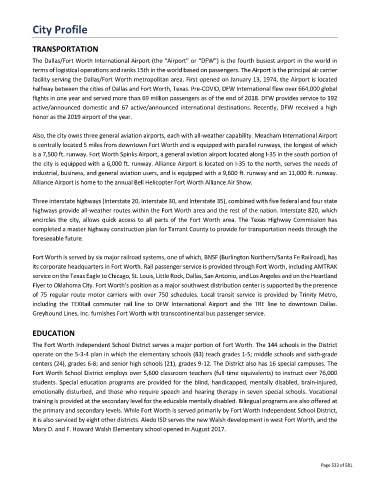Page 533 - FortWorthFY22AdoptedBudget
P. 533
City Profile
TRANSPORTATION
The Dallas/Fort Worth International Airport (the "Airport" or “DFW”) is the fourth busiest airport in the world in
terms of logistical operations and ranks 15th in the world based on passengers. The Airport is the principal air carrier
facility serving the Dallas/Fort Worth metropolitan area. First opened on January 13, 1974, the Airport is located
halfway between the cities of Dallas and Fort Worth, Texas. Pre-COVID, DFW International flew over 664,000 global
flights in one year and served more than 69 million passengers as of the end of 2018. DFW provides service to 192
active/announced domestic and 67 active/announced international destinations. Recently, DFW received a high
honor as the 2019 airport of the year.
Also, the city owns three general aviation airports, each with all-weather capability. Meacham International Airport
is centrally located 5 miles from downtown Fort Worth and is equipped with parallel runways, the longest of which
is a 7,500 ft. runway. Fort Worth Spinks Airport, a general aviation airport located along I-35 in the south portion of
the city is equipped with a 6,000 ft. runway. Alliance Airport is located on I-35 to the north, serves the needs of
industrial, business, and general aviation users, and is equipped with a 9,600 ft. runway and an 11,000 ft. runway.
Alliance Airport is home to the annual Bell Helicopter Fort Worth Alliance Air Show.
Three interstate highways (Interstate 20, Interstate 30, and Interstate 35), combined with five federal and four state
highways provide all-weather routes within the Fort Worth area and the rest of the nation. Interstate 820, which
encircles the city, allows quick access to all parts of the Fort Worth area. The Texas Highway Commission has
completed a master highway construction plan for Tarrant County to provide for transportation needs through the
foreseeable future.
Fort Worth is served by six major railroad systems, one of which, BNSF (Burlington Northern/Santa Fe Railroad), has
its corporate headquarters in Fort Worth. Rail passenger service is provided through Fort Worth, including AMTRAK
service on the Texas Eagle to Chicago, St. Louis, Little Rock, Dallas, San Antonio, and Los Angeles and on the Heartland
Flyer to Oklahoma City. Fort Worth’s position as a major southwest distribution center is supported by the presence
of 75 regular route motor carriers with over 750 schedules. Local transit service is provided by Trinity Metro,
including the TEXRail commuter rail line to DFW International Airport and the TRE line to downtown Dallas.
Greyhound Lines, Inc. furnishes Fort Worth with transcontinental bus passenger service.
EDUCATION
The Fort Worth Independent School District serves a major portion of Fort Worth. The 144 schools in the District
operate on the 5-3-4 plan in which the elementary schools (83) teach grades 1-5; middle schools and sixth-grade
centers (24), grades 6-8; and senior high schools (21), grades 9-12. The District also has 16 special campuses. The
Fort Worth School District employs over 5,600 classroom teachers (full-time equivalents) to instruct over 76,000
students. Special education programs are provided for the blind, handicapped, mentally disabled, brain-injured,
emotionally disturbed, and those who require speech and hearing therapy in seven special schools. Vocational
training is provided at the secondary level for the educable mentally disabled. Bilingual programs are also offered at
the primary and secondary levels. While Fort Worth is served primarily by Fort Worth Independent School District,
it is also serviced by eight other districts. Aledo ISD serves the new Walsh development in west Fort Worth, and the
Mary D. and F. Howard Walsh Elementary school opened in August 2017.
Page 533 of 581

